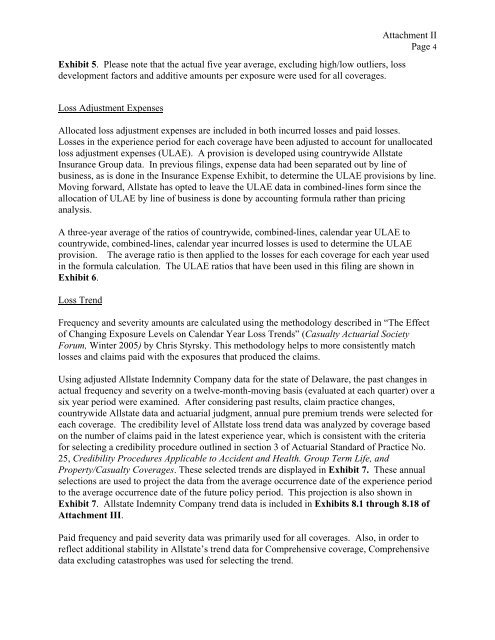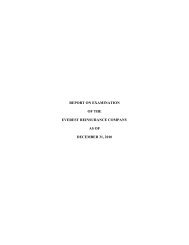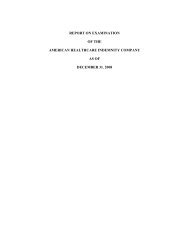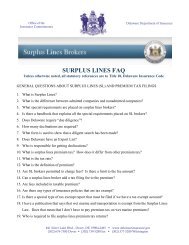Filing at a Glance General Information - Delaware Insurance ...
Filing at a Glance General Information - Delaware Insurance ...
Filing at a Glance General Information - Delaware Insurance ...
You also want an ePaper? Increase the reach of your titles
YUMPU automatically turns print PDFs into web optimized ePapers that Google loves.
Exhibit 5. Please note th<strong>at</strong> the actual five year average, excluding high/low outliers, loss<br />
development factors and additive amounts per exposure were used for all coverages.<br />
Loss Adjustment Expenses<br />
Attachment II<br />
Page 4<br />
Alloc<strong>at</strong>ed loss adjustment expenses are included in both incurred losses and paid losses.<br />
Losses in the experience period for each coverage have been adjusted to account for unalloc<strong>at</strong>ed<br />
loss adjustment expenses (ULAE). A provision is developed using countrywide Allst<strong>at</strong>e<br />
<strong>Insurance</strong> Group d<strong>at</strong>a. In previous filings, expense d<strong>at</strong>a had been separ<strong>at</strong>ed out by line of<br />
business, as is done in the <strong>Insurance</strong> Expense Exhibit, to determine the ULAE provisions by line.<br />
Moving forward, Allst<strong>at</strong>e has opted to leave the ULAE d<strong>at</strong>a in combined-lines form since the<br />
alloc<strong>at</strong>ion of ULAE by line of business is done by accounting formula r<strong>at</strong>her than pricing<br />
analysis.<br />
A three-year average of the r<strong>at</strong>ios of countrywide, combined-lines, calendar year ULAE to<br />
countrywide, combined-lines, calendar year incurred losses is used to determine the ULAE<br />
provision. The average r<strong>at</strong>io is then applied to the losses for each coverage for each year used<br />
in the formula calcul<strong>at</strong>ion. The ULAE r<strong>at</strong>ios th<strong>at</strong> have been used in this filing are shown in<br />
Exhibit 6.<br />
Loss Trend<br />
Frequency and severity amounts are calcul<strong>at</strong>ed using the methodology described in “The Effect<br />
of Changing Exposure Levels on Calendar Year Loss Trends” (Casualty Actuarial Society<br />
Forum, Winter 2005) by Chris Styrsky. This methodology helps to more consistently m<strong>at</strong>ch<br />
losses and claims paid with the exposures th<strong>at</strong> produced the claims.<br />
Using adjusted Allst<strong>at</strong>e Indemnity Company d<strong>at</strong>a for the st<strong>at</strong>e of <strong>Delaware</strong>, the past changes in<br />
actual frequency and severity on a twelve-month-moving basis (evalu<strong>at</strong>ed <strong>at</strong> each quarter) over a<br />
six year period were examined. After considering past results, claim practice changes,<br />
countrywide Allst<strong>at</strong>e d<strong>at</strong>a and actuarial judgment, annual pure premium trends were selected for<br />
each coverage. The credibility level of Allst<strong>at</strong>e loss trend d<strong>at</strong>a was analyzed by coverage based<br />
on the number of claims paid in the l<strong>at</strong>est experience year, which is consistent with the criteria<br />
for selecting a credibility procedure outlined in section 3 of Actuarial Standard of Practice No.<br />
25, Credibility Procedures Applicable to Accident and Health. Group Term Life, and<br />
Property/Casualty Coverages. These selected trends are displayed in Exhibit 7. These annual<br />
selections are used to project the d<strong>at</strong>a from the average occurrence d<strong>at</strong>e of the experience period<br />
to the average occurrence d<strong>at</strong>e of the future policy period. This projection is also shown in<br />
Exhibit 7. Allst<strong>at</strong>e Indemnity Company trend d<strong>at</strong>a is included in Exhibits 8.1 through 8.18 of<br />
Attachment III.<br />
Paid frequency and paid severity d<strong>at</strong>a was primarily used for all coverages. Also, in order to<br />
reflect additional stability in Allst<strong>at</strong>e’s trend d<strong>at</strong>a for Comprehensive coverage, Comprehensive<br />
d<strong>at</strong>a excluding c<strong>at</strong>astrophes was used for selecting the trend.






